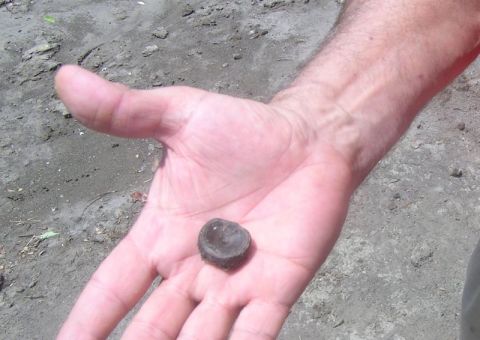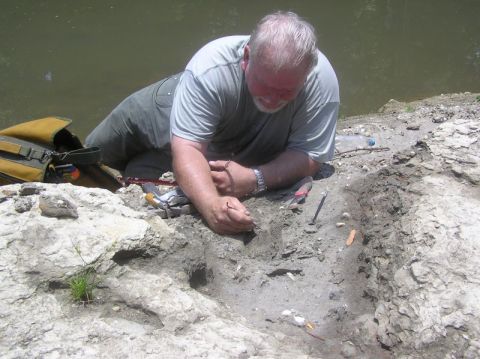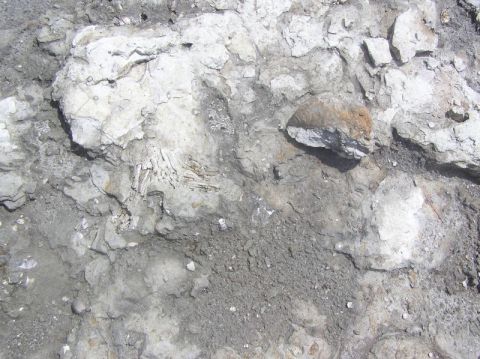First we need the canoe way down the bluff to the river bank so we can paddle downstream. Well, now wait a minute. This river has always been much higher, all the way into the weeds, and you couldn't walk here, summer nor winter. What's going on here? We don't need the canoe after all!
Visitor
mosasaur vertebra
08-06-vl-vertebra-252
Five or six baby mosasaur vertebra were found in the roots of the tree.
08-05-vl-vertebra-tooth-422
Shark teeth, enchodus tooth and tiny mosasaur vertebra.
08-05-vl-fossils-bob-448
Shark teeth, enchodus tooth, mosasaur vertebra
June 24, 2006 - Cretaceous Fossils, Montgomery and Elmore Co, AL
A relatively small group of BPS members went to a creek in Montgomery County for today's trip - could it be some people were scared off by the thoughts of 95 degree weather in the sweltering sun? To get an idea of our weather, go to your bathroom, turn the shower on the hottest it will go, close the door so steam can build up, turn off the A/C, then take your laptop in there and view our trip photos - you will have a good idea of our day! Leisa brought her canoe, and she and Claire floated/pushed/dragged it upstream and then back down. This late Cretaceous site once again yielded numerous echinoids and ammonites, though most of the ammonites could only be "collected" via photos, due to their fragile composition. We also found huge quantities of shells, a few shark teeth, a couple of mosasaur vertebra, two large vertebra, possibly shark, and pyritized coprolites.
Several people decided to call it a day after getting too hot for comfort. After a refreshing afternoon lunch in an air conditioned restaurant, the die-hards brains began coming up with another potential collecting site in Elmore county. Since we have a canoe, lets go look for petrified wood. Now understand, we had one canoe, one paddle, 3 life jackets and 4 people to go on this escapade. After a quick stop at the local discount store for an additional paddle and PDF, we scouted access points. The put-in we decided on was steep. Really steep. Really really steep. But we finally got it down the several hundred feet to the water, only to find a boat wasn't necessary, the water was low, the shore was easily walkable, and petrified wood was everywhere. So we collected it (ask Jan how much his pack weighed!), took some pictures of a tree that was about 4 feet in diameter, and noticed it was getting darker. And windy. And there was thunder. And lightning. And lots of cold rain (boy, did it feel good!) And we had the canoe at the bottom of a huge hill. But Leisa, resourceful as ever, had a plan; just hook the boat to her van, and pull it out.
(photos courtesy Vicki Lais)
Leisa very quickly found a nice vertebra. After collecting the vertebra, Leisa and Claire headed up the creek, and we didn't see them again for several hours.
Claire has found a couple of shark teeth, one still embedded in the rock matrix.
Not sure what this is, shaped like an ear bone, but looks like pottery, very smooth and obviously supposed to be shaped this way, not very worn looking.
Claire also found a pile of sh#!, um, well, or rather, a bag of pyritized coprolites!
Greg is carefully excavating a small bone. Another piece of bone was found about 1' away from this one.
Jan is wondering just exactly how we plan to pull this off. Perhaps he made a hasty decision to come along, as the others didn't seem to be giving any thought to the difficulty of what we were proposing. The river is down an extremely steep slope.
So we "park" the boat, and go along the bank collecting large pieces of petrified wood. The weather is getting ominous. The wind is picking up, we hear thunder and see rain off in the distance. But we just got here, and we've got to get that boat back up the steep slope!
Wow, looks like we may have to come back to get this one, it won't fit in the canoe . . . .
Some echinoids and shark teeth from Vicki's bag. About 2pm, we were so hot, we needed a break from the heat, so a small group met at a nearby restaurant to cool our brains. And we decided to go check out a river site since we had the canoe.
I knew it, I knew it, I knew it, look what they've gotten me into now! Just getting started up the steep bank. Worn out from the distance already covered, and soaking wet from the recent rain shower. But it was fun, and we had our adventure for the day!
Look carefully and you can see several shell impressions in this rock, along with some shells scattered in the dirt.
Shells and echinoids in matrix. These rocks are pretty hard, so these were left in place.
Melanie found a nice gastropod in the same area where the tiny shark teeth were found.
Tree trunk breaking into pieces on the bank. Numerous pieces like this were scattered everywhere.
- ‹ previous
- 2 of 3
- next ›
March 19, 2005 - Cretaceous Fossils, Greene Co, AL
(Photos courtesy Steve Corvin and Vicki Lais.) 
Getting to know you . . .

Checking out the show and tell.
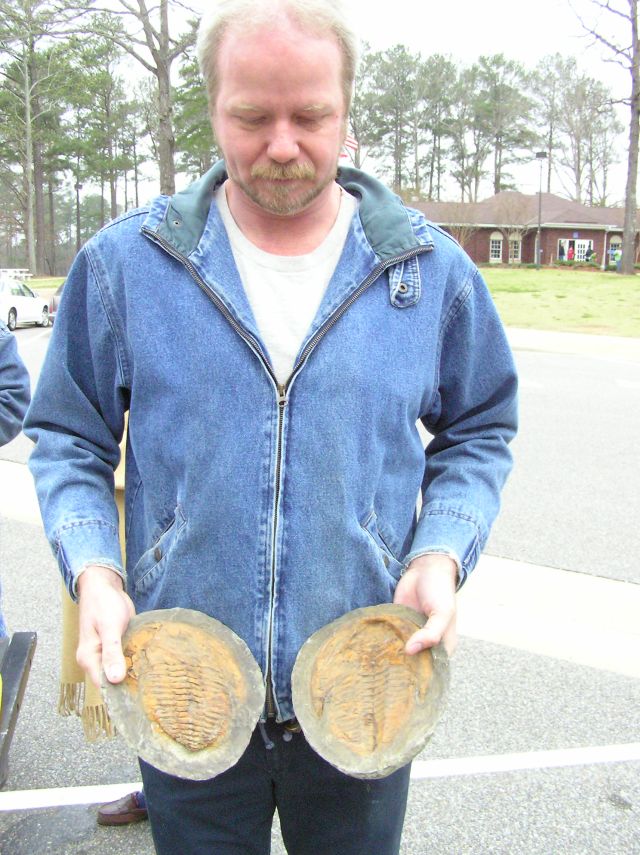
No, it didn't come from last months Cherokee County trip, dang it!

Even the Easter Bunny came!
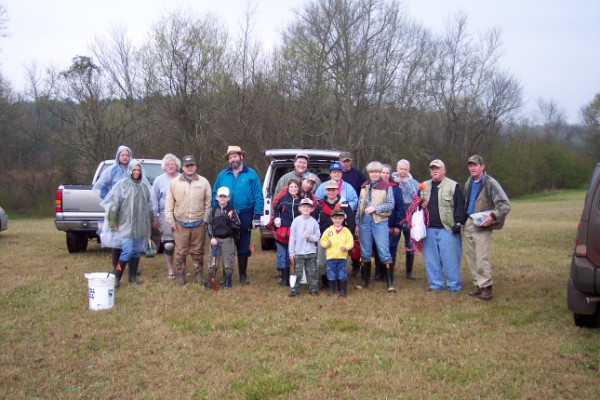
Arrival at the collecting spot (+ Steve, behind the camera!)

Some of Steve's finds.

Bobby and grandson Noah.

Lea and Paige, dilligently searching for more shark teeth. What's in your bucket, Paige?

Some of Paige's finds.

Carl and grandson Daniel, enjoying the day.

Claire, Leisa, and Bill. Notice the variety of "tools" being used.

Ramsey and Sarah came prepared!

Marjorie examining a recent find. What's in your bucket?

Some of Marjorie's finds. Nice fish vertebra.

Len and Daniel, way down the creek.

An untouched stretch of sand and gravel bars, no footprints in sight. All Right!!

Mosasaur vertebra found by Vicki, this makes 3, one per trip! Nice find!

Bone is about 5 inches long along the longest side, possibly plesiosaur. (Vicki plans to call it a plesiosaur until someone convinces her otherwise!)
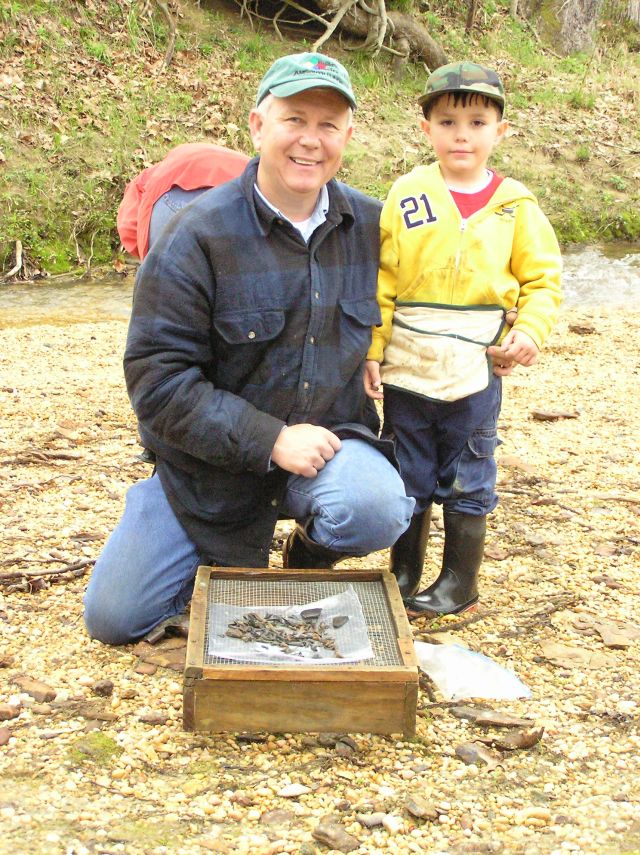
Steve and Steve, with some of their finds.

Closer view of Steve and Steve's finds.
















